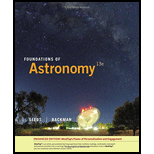
Foundations of Astronomy, Enhanced
13th Edition
ISBN: 9781305980686
Author: Michael A. Seeds; Dana Backman
Publisher: Cengage Learning US
expand_more
expand_more
format_list_bulleted
Concept explainers
Question
Chapter 11, Problem 14P
To determine
The wavelength at which maximum energy emission is observed at
Expert Solution & Answer
Trending nowThis is a popular solution!

Students have asked these similar questions
If the hottest star in the Carina Nebula has a surface temperature of 51,000 K, at what wavelength (in nm) does it radiate the most energy?
Hint: Use Wien's law:
?max =
2.90 ✕ 106 nm · K
T
How does that compare with 91.2 nm, the wavelength of photons with just enough energy to ionize hydrogen?
-The wavelength calculated above is shorter than 91.2 nm. Photons at this calculated wavelength will have more than enough energy to ionize hydrogen.
-The wavelength calculated above is longer than 91.2 nm. Photons at this calculated wavelength will have more than enough energy to ionize hydrogen.
-The wavelength calculated above is shorter than 91.2 nm. Photons at this calculated wavelength will not have enough energy to ionize hydrogen.
-The wavelength calculated above is longer than 91.2 nm. Photons at this calculated wavelength will not have enough energy to ionize hydrogen.
Assuming that at the end of the He burning phase of the stellar core (r < R_core) has no H or He or other metals and is composed completely of Carbon, X=Y=0, X_c = 1 ; The envelope above the core has a normal stellar composition ( r > R_core). Calculate the length of time in years that a 1M_sol and 10M_sol star will live on the horizontal branch or the time between the start and end of the He burning phase. Assume that the normal relationship between mass and luminosity holds for horizontal branch stars. Please be as detailed as possible
A planet orbits 1 AU from a star that is 3.5 times as massive as our Sun. How does the star's luminosity compare?
If the star has the same radius as our Sun, what is the temperature of the star compared to the Sun?
If Earth's average temperature is 287 K and the Sun were replaced with this star, how would its average temperature change? (Enter a temperature in K. Assume that Earth temperature is proportional to solar flux.)
Chapter 11 Solutions
Foundations of Astronomy, Enhanced
Ch. 11 - Prob. 1RQCh. 11 - Prob. 2RQCh. 11 - Prob. 3RQCh. 11 - Prob. 4RQCh. 11 - Prob. 5RQCh. 11 - Prob. 6RQCh. 11 - Prob. 7RQCh. 11 - Prob. 8RQCh. 11 - Prob. 9RQCh. 11 - Prob. 10RQ
Ch. 11 - Prob. 11RQCh. 11 - Prob. 12RQCh. 11 - Prob. 13RQCh. 11 - Prob. 14RQCh. 11 - Describe the three ways thermal energy can be...Ch. 11 - Prob. 16RQCh. 11 - Prob. 17RQCh. 11 - How does the CNO cycle differ from the...Ch. 11 - Prob. 19RQCh. 11 - Prob. 20RQCh. 11 - Prob. 21RQCh. 11 - Prob. 22RQCh. 11 - Prob. 23RQCh. 11 - Prob. 24RQCh. 11 - Prob. 25RQCh. 11 - Prob. 1DQCh. 11 - Prob. 2DQCh. 11 - Prob. 3DQCh. 11 - Prob. 4DQCh. 11 - Prob. 5DQCh. 11 - Prob. 6DQCh. 11 - Prob. 1PCh. 11 - Prob. 2PCh. 11 - Prob. 3PCh. 11 - Prob. 4PCh. 11 - If a protostellar disk is 200 AU in radius and the...Ch. 11 - Prob. 6PCh. 11 - Prob. 7PCh. 11 - Prob. 8PCh. 11 - Prob. 9PCh. 11 - Prob. 10PCh. 11 - Prob. 11PCh. 11 - Prob. 12PCh. 11 - If the Orion Nebula is 8 pc in diameter and has a...Ch. 11 - Prob. 14PCh. 11 - Prob. 1LTLCh. 11 - Prob. 2LTLCh. 11 - Prob. 3LTLCh. 11 - Prob. 4LTLCh. 11 - Prob. 5LTLCh. 11 - Prob. 6LTL
Knowledge Booster
Learn more about
Need a deep-dive on the concept behind this application? Look no further. Learn more about this topic, physics and related others by exploring similar questions and additional content below.Similar questions
- For a main sequence star with luminosity L, how many kilograms of hydrogen is being converted into helium per second? Use the formula that you derive to estimate the mass of hydrogen atoms that are converted into helium in the interior of the sun (LSun = 3.9 x 1026 W). (Note: the mass of a hydrogen atom is 1 mproton and the mass of a helium atom is 3.97 mproton. You need four hydrogen nuclei to form one helium nucleus.)arrow_forwardH II regions can exist only if there is a nearby star hot enough to ionize hydrogen. Hydrogen is ionized only by radiation with wavelengths shorter than 91.2 nm. What is the temperature of a star that emits its maximum energy at 91.2 nm? (Use Wien’s law from Radiation and Spectra.) Based on this result, what are the spectral types of those stars likely to provide enough energy to produce H II regions?arrow_forwardWhy do nebulae near hot stars look red? Why do dust clouds near stars usually look blue?arrow_forward
Recommended textbooks for you
 Stars and Galaxies (MindTap Course List)PhysicsISBN:9781337399944Author:Michael A. SeedsPublisher:Cengage Learning
Stars and Galaxies (MindTap Course List)PhysicsISBN:9781337399944Author:Michael A. SeedsPublisher:Cengage Learning Foundations of Astronomy (MindTap Course List)PhysicsISBN:9781337399920Author:Michael A. Seeds, Dana BackmanPublisher:Cengage Learning
Foundations of Astronomy (MindTap Course List)PhysicsISBN:9781337399920Author:Michael A. Seeds, Dana BackmanPublisher:Cengage Learning
 Stars and GalaxiesPhysicsISBN:9781305120785Author:Michael A. Seeds, Dana BackmanPublisher:Cengage Learning
Stars and GalaxiesPhysicsISBN:9781305120785Author:Michael A. Seeds, Dana BackmanPublisher:Cengage Learning AstronomyPhysicsISBN:9781938168284Author:Andrew Fraknoi; David Morrison; Sidney C. WolffPublisher:OpenStax
AstronomyPhysicsISBN:9781938168284Author:Andrew Fraknoi; David Morrison; Sidney C. WolffPublisher:OpenStax

Stars and Galaxies (MindTap Course List)
Physics
ISBN:9781337399944
Author:Michael A. Seeds
Publisher:Cengage Learning

Foundations of Astronomy (MindTap Course List)
Physics
ISBN:9781337399920
Author:Michael A. Seeds, Dana Backman
Publisher:Cengage Learning


Stars and Galaxies
Physics
ISBN:9781305120785
Author:Michael A. Seeds, Dana Backman
Publisher:Cengage Learning

Astronomy
Physics
ISBN:9781938168284
Author:Andrew Fraknoi; David Morrison; Sidney C. Wolff
Publisher:OpenStax